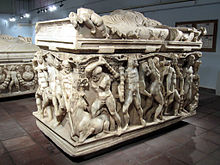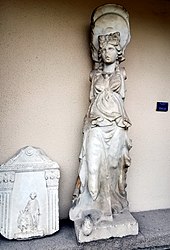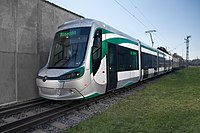Konya
Konya | ||
|---|---|---|
Mevlana Museum | ||
|
Licence plate 42 | | |
| Website | www | |
Konya (Turkish pronunciation:
As of 2023, the population of the Metropolitan Province was just over 2.3 million, making it the
Name
Konya is believed to correspond to the
A
Konya was known as Dârülmülk to the Rum Seljuks.[9]
History
Overview
The Konya region has been inhabited since the third millennium BC and fell at different times under the rule of
Ancient history



Excavations have shown that the region was inhabited during the Late
The Phrygians established their kingdom in central Anatolia in the eighth century BC and Xenophon describes Iconium (as the city was originally called) as the last city of Phrygia. The region was overwhelmed by Cimmerian invaders c. 690 BC. Later it formed part of the Persian Empire, until Darius III was defeated by Alexander the Great in 333 BC. Alexander's empire broke up shortly after his death and the town came under the rule of Seleucus I Nicator.
During the Hellenistic period the town was ruled by the kings of Pergamon. As Attalus III, the last king of Pergamon, was about to die without an heir, he bequeathed his kingdom to the Roman Republic. Once incorporated into the Roman Empire, under emperor Claudius, the city's name was changed to Claudiconium. During the reign of emperor Hadrianus it was known as Colonia Aelia Hadriana.
St Paul and Iconium
According to the
According to the
Byzantine Era
Under the
The
Seljuk and Karamanid eras

Iconium became the second capital of the

Konya reached the height of its wealth and influence in the second half of the 12th century when the Seljuk sultans of Rum also subdued the
Many
Following the fall of the
Ottoman Empire
Under
.Between 1483 and 1864, Konya was the administrative capital of the
In 1832 Anatolia was invaded by Mehmed Ali Paşa of Kavala whose son, İbrahim Paşa, occupied Konya. Although he was driven out with the help of the European powers, Konya went into a decline after this, as described by the British traveller, William Hamilton, who visited in 1837 and found a scene 'of destruction and decay', as he recorded in his Researches in Asia Minor, Pontus and Armenia, published in 1842.[27]
Konya's textile and mining industries flourished under the Ottomans.[28]
Turkish Republic

During the Turkish War of Independence (1919–22) Konya was a major air base. In 1922, the air force, renamed as the Inspectorate of Air Forces,[a] was headquartered in Konya.[29][30] Before 1923, 4,000 Orthodox, Turkish-speaking and Greek-speaking Christians lived there. The Greek community numbered approximately 2,500 people who maintained, at their own expense, a church, a boys' school and a girls' school. In 1923 during the population exchange between Greece and Turkey, the Greeks of the nearby village of Sille were forced to leave as refugees and resettle in Greece.[31]
Government

The first local administration in Konya was founded in 1830 and converted into a municipality in 1876.[b] In March 1989, the municipality became a Metropolitan Municipality. As of that date, Konya had three central district municipalities (Meram, Selçuklu, Karatay) and a Metropolitan Municipality.
Economy
Home to several industrial parks. The city ranks among the Anatolian Tigers.[32][33][34][35] In 2012 exports from Konya reached 130 countries.[35] A number of Turkish industrial conglomerates, such as Bera (ex Kombassan) Holding, have their headquarters in Konya.[36]
While agriculture-based industries play a role, the city's economy has evolved into a center for the manufacturing of components for the automotive industry; machinery manufacturing; agricultural tools; casting; plastic paints and chemicals; construction materials; paper and packaging; processed foods; textiles; and leather.[35]
Turkey's largest solar farm is located 20 miles East of the city near Karapınar.[37]
Geography
Konya sits in the center of the largest province, in the largest plain (Konya Plain), and is the seventh most heavily populated city in Turkey.[38]

The city is in the southern part of the Central Anatolia Region with the southernmost side of the province hemmed in by the Taurus Mountains.
Climate
Konya has a cold semi-arid climate (BSk) under the Köppen classification[39] and a temperate continental (Dc) climate under the Trewartha classification.
Summer daytime temperatures average 30 °C (86 °F), although summer nights are cool. The highest temperature recorded in Konya was 40.9 °C (106 °F) on 14 August 2023, closely beating the former record of 40.6 °C (105 °F) on 30 July 2000. Winters average −4.2 °C (24 °F), and the lowest temperature recorded was −26.5 °C (−16 °F) on 6 February 1972. Precipitation levels are low and happen mainly in winter and spring.
| Climate data for Konya (1991–2020, extremes 1929–2023) | |||||||||||||
|---|---|---|---|---|---|---|---|---|---|---|---|---|---|
| Month | Jan | Feb | Mar | Apr | May | Jun | Jul | Aug | Sep | Oct | Nov | Dec | Year |
| Record high °C (°F) | 19.3 (66.7) |
23.8 (74.8) |
28.9 (84.0) |
34.6 (94.3) |
34.4 (93.9) |
36.7 (98.1) |
40.6 (105.1) |
40.9 (105.6) |
38.8 (101.8) |
32.3 (90.1) |
25.4 (77.7) |
21.8 (71.2) |
40.6 (105.1) |
| Mean daily maximum °C (°F) | 4.6 (40.3) |
6.9 (44.4) |
12.5 (54.5) |
17.6 (63.7) |
22.8 (73.0) |
27.4 (81.3) |
31.0 (87.8) |
30.9 (87.6) |
26.7 (80.1) |
20.4 (68.7) |
12.7 (54.9) |
6.3 (43.3) |
18.3 (64.9) |
| Daily mean °C (°F) | −0.3 (31.5) |
1.3 (34.3) |
6.0 (42.8) |
10.9 (51.6) |
15.9 (60.6) |
20.5 (68.9) |
24.1 (75.4) |
24.0 (75.2) |
19.4 (66.9) |
13.4 (56.1) |
6.2 (43.2) |
1.5 (34.7) |
11.9 (53.4) |
| Mean daily minimum °C (°F) | −3.9 (25.0) |
−3.3 (26.1) |
0.2 (32.4) |
4.4 (39.9) |
9.0 (48.2) |
13.6 (56.5) |
17.1 (62.8) |
17.2 (63.0) |
12.3 (54.1) |
7.0 (44.6) |
0.8 (33.4) |
−2.2 (28.0) |
6.0 (42.8) |
| Record low °C (°F) | −28.2 (−18.8) |
−26.5 (−15.7) |
−16.4 (2.5) |
−8.6 (16.5) |
−1.2 (29.8) |
1.8 (35.2) |
6.0 (42.8) |
5.3 (41.5) |
−3.0 (26.6) |
−8.4 (16.9) |
−20.0 (−4.0) |
−26.0 (−14.8) |
−28.2 (−18.8) |
| Average precipitation mm (inches) | 35.9 (1.41) |
23.1 (0.91) |
27.4 (1.08) |
34.2 (1.35) |
38.2 (1.50) |
27.8 (1.09) |
6.5 (0.26) |
6.5 (0.26) |
15.9 (0.63) |
29.7 (1.17) |
34.5 (1.36) |
45.6 (1.80) |
325.3 (12.81) |
| Average precipitation days | 10.53 | 8.97 | 9.80 | 10.83 | 12.47 | 8.10 | 3.00 | 2.63 | 4.40 | 7.27 | 7.13 | 10.10 | 95.2 |
| Average relative humidity (%)
|
79.8 | 73.3 | 63.4 | 58.7 | 56.1 | 47.5 | 38.9 | 39.4 | 44.2 | 57.6 | 70.1 | 79.9 | 59.0 |
| Mean monthly sunshine hours | 105.4 | 138.4 | 195.3 | 216.0 | 269.7 | 309.0 | 344.1 | 334.8 | 291.0 | 235.6 | 159.0 | 102.3 | 2,700.6 |
| Mean daily sunshine hours | 3.4 | 4.9 | 6.3 | 7.2 | 8.7 | 10.3 | 11.1 | 10.8 | 9.7 | 7.6 | 5.3 | 3.3 | 7.4 |
| Source 1: Turkish State Meteorological Service[40] | |||||||||||||
| Source 2: NOAA (humidity)[41]
| |||||||||||||
Culture

Konya has a reputation for being one of the more religiously conservative metropolitan centres in Turkey.[42]
Konya was the final home of
Every Saturday, there are Whirling Dervish performances (semas) at the Mevlana Cultural Centre. Unlike some of the commercial performances staged in cities like Istanbul, these are genuinely spiritual sessions.
Expensive, richly patterned Konya
Attractions

- Mevlâna Museum
- Alaaddin Mosque
- Ince Minaret Medrese—Museum[45]
- Karatay Medrese—Museum[45]
- Sırçalı Medrese
- Sahib-i Ata Mosque complex
- Konya Archaeological and Ethnography Museum[46]
- Koyunoğlu Museum
- Atatürk House Museum[45]
- Mevlana Cultural Centre[47]
- Mevlana Festival
- Selimiye Mosque
- Aziziye Mosque
- Konya Science Centre (Turkish: Konya Bilim Merkezi)
- Konya Tropical Butterfly Garden
- Meram, suburb with popular waterside picnicking facilities
- Sille, 8 kilometres (5.0 miles) northwest from Mevlana Museum: antique village, mosques, churches, cave churches and catacombs
- Çatalhöyük
Food
One of the city's best-known dishes,

Konya is also known for its sweets, including cezerye, an old Turkish sweet made from carrots, and pişmaniye, which is similar to American cotton candy.
Sports
The city's football team Konyaspor is part of the Turkish Professional Football League. On May 31, 2017, they won their first national trophy, beating İstanbul Başakşehir to the Türkiye Kupası in a penalty shootout. They repeated this success on August 6, 2017, defeating Beşiktaş to win the Türkiye Süper Kupası (Turkish Super Bowl).
The city hosted the
Education
Founded in 1975,

Private colleges in Konya include the KTO Karatay University.
Konya hosts the
Transportation

Intercity buses
The central bus station has connections to a range of destinations, including Istanbul, Ankara and İzmir. It is connected to the town centre by a tram.
Inner-city public transport
The Konya Tram network is 41 km (25 mi) long and has two lines with 41 stations. Opened in 1992, it was expanded in 1996 and 2015. The Konya Tram uses Škoda 28 T vehicles.[53]
Work began on building a Konya Metro in 2020 and is expected to be completed in 2024 and will have 22 stations.[54]
Konya also has an extensive inner-city bus network.
Railway
Konya is connected to Ankara, Eskişehir, Istanbul and Karaman via the high-speed railway services of the Turkish State Railways.[55][56]
Airport and airbase
Notable people
- Amphilochius of Iconium, fourth century Christian bishop.[60]
- Prokopios Lazaridis, Greek Orthodox metropolitan bishop of the Metropolis of Iconium[61][62]
- Murat Yıldırım (actor), actor and presenter
- Hilmi Şenalp (1957-), architect.[63]
Twin towns – sister cities
Konya is twinned with:
See also
- Mevlâna Museum
- Anatolian Tigers
- Konya Carpets and Rugs
- Theodosius the Cenobiarch (c. 423–529 AD), monk, abbot, and saint born in Iconium; a founder and organiser of the cenobitic way of monastic life
- Thecla or Tecla, first-century virgin saint of early Christian Church born in Iconium
Notes
References
- ^ "Turkey: Administrative Division (Provinces and Districts) - Population Statistics, Charts and Map".
- ^ "Statistics by Theme > National Accounts > Regional Accounts". www.turkstat.gov.tr. Retrieved 11 May 2023.
- .
- ISBN 9780415349550.
- ISBN 978-3-11-026128-8.
- ISBN 9780415349550.
- ISBN 978-3-11-026128-8.
- ^ a b "Konya". Encyclopædia Britannica. Retrieved 25 May 2015.
- TDV Encyclopedia of Islam (44+2 vols.) (in Turkish). Istanbul: Turkiye Diyanet Foundation, Centre for Islamic Studies. 1988–2016.
- ^ Acts 13:51
- ^ Acts 14:1–5
- ^ Acts 14:21)
- ^ 2 Timothy 3:10–13
- ^ "Acts 14 Barnes' Notes". Bible Hub. Retrieved 2019-08-29.
- ^ Acts 16:2
- ^ Ramsay, William Mitchell (1908). The Cities of St. Paul. A.C. Armstrong. pp. 315–384.
- ISBN 978-0-8028-3501-7.
- ^ Acts 19:1
- ISBN 978-0-8028-3501-7.
- ^ ISBN 978-0-19-504652-6.
- ISBN 9780520204966. Retrieved 6 October 2023.
- ISBN 9780802066671. Retrieved 6 October 2023.
- .
- ISBN 9789004352520.
- ISBN 978-0-7156-4038-8.
- OCLC 309327.
- ISBN 9758176226.
- S2CID 244587800.
- ^ "Bir Hata Oluştu". Hvkk.tsk.tr. Archived from the original on 5 May 2015. Retrieved 25 May 2015.
- ^ Kocatürk, Utkan (1983). Atatürk ve Türkiye Cumhuriyeti tarihi kronolojisi, 1918–1938 (in Turkish). Türk Tarih Kurumu Basımevi. p. 634.
- ^ "IFMSA Exchange Portal". Exchange.ifmsa.org. Retrieved 7 August 2018.
- ^ "Financial Times: Reports — Anatolian tigers: Regions prove plentiful". Ft.com. Archived from the original on 2022-12-10. Retrieved 7 August 2018.
- ^ root. "Anatolian Tigers". Investopedia. Retrieved 25 May 2015.
- ^ "Zaman: Anatolian tigers conquering the world". Archived from the original on 2013-08-21. Retrieved 2013-08-21.
- ^ a b c "General Overview Of The Konya Economy". En.kto.org.tr. Retrieved 25 May 2015.
- ^ "Anasayfa | Bera Holding". beraholding.com.tr. Retrieved 2022-07-21.
- ^ "The World's Largest Solar Power Plant in Konya". TR Dergisi. 2017-05-15. Retrieved 2022-07-21.
- ^ "Turkey: Provinces & Major Cities – Statistics & Maps on City Population". Archived from the original on 2017-01-14. Retrieved 2013-12-31.
- ^ "Updated world map of the Köppen-Geiger climate classification" (PDF). Hydrology and Earth System Sciences Discussions. Retrieved 7 August 2018.
- ^ "Resmi İstatistikler: İllerimize Ait Mevism Normalleri (1991–2020)" (in Turkish). Turkish State Meteorological Service. Retrieved 6 July 2021.
- National Centers for Environmental Information. Retrieved 2 August 2023.
- ^ "'Islam problem' baffles Turkey". BBC News. 2004-12-03. Retrieved 2019-08-29.
- ISBN 978-0-19-518948-3.
- ^ "Carpets of the Ottoman Period". Old Turkish Carpets. 2019-06-19. Retrieved 2019-08-29.
- ^ a b c "Konya Museums and Ruins". www.ktb.gov.tr.
- ISBN 978-1-898249-14-6. Retrieved 7 August 2018 – via Google Books.
- ^ "Mevlâna Culture Centre | Konya, Turkey | Entertainment - Lonely Planet".
- ^ "Konya Büyükşehir Belediyesi". Konya.bel.tr (in Turkish). Archived from the original on 2018-08-08. Retrieved 2019-08-29.
- ^ "Small Ruminant Congress". kucukbas2014.com. 2014-10-18. Archived from the original on 2014-10-18. Retrieved 2019-08-29.
{{cite web}}: CS1 maint: unfit URL (link) - ^ "Konya Necmettin Erbakan Üniversitesi". Archived from the original on 27 April 2015. Retrieved 25 May 2015.
- ^ "KTO Karatay Üniversitesi". Karatay.edu.tr. Retrieved 2011-09-16.
- ^ Official Web Site
- ^ "Škoda Transportation wins Konya tram contract". Railway Gazette. 2013-03-04. Retrieved 2019-08-29.
- ^ Uysal, Onur (2020-10-01). "Last status of metro and tram projects of Turkey". Rail Turkey En. Retrieved 2022-07-22.
- ^ "Opening of Ankara – Konya fast line completes strategic link". Railway Gazette. 24 August 2011. Retrieved 2013-02-12.
- ^ "Invensys commissions ERTMS solution on Turkish High Speed Line". European Railway Review. 7 September 2011. Archived from the original on 6 January 2012. Retrieved 20 December 2011.
- ^ Mehmet Kayhan YILDIZ- Hasan BÖLÜKBAŞ- Serdar ÖZGÜR- Tolga YANIK- Hasan DÖNMEZ/ KONYA,(DHA). "TSK yeni yıldızı Barış Kartalı'na kavuştu". HÜRRİYET – TÜRKİYE'NİN AÇILIŞ SAYFASI. Retrieved 25 May 2015.
- ^ "Turkey takes delivery of military aircraft". TodaysZaman. Archived from the original on February 22, 2015. Retrieved 25 May 2015.
- ISBN 978-0-330-41879-9.
- S2CID 162127197.
- ^ Savramis, Demosthenes (1968). Die soziale Stellung des Priesters in Griechenland [Social position of the priest in Greece] (in German). E. J. Brill.
- ISBN 978-1-4344-5876-6.
- ISBN 978-1-4696-2117-3. Retrieved 16 May 2020.
- ^ "Rumi Remembered in Birthplace of Shams". Archived from the original on 7 April 2015. Retrieved 21 March 2015.
- ^ Kyoto İle Kardeş Şehir Protokolü İmzalandı, Heyet Japon Parkı'nı Gezdi Archived 2014-10-16 at the Wayback Machine, Konya Büyükşehir Belediyesi (2010)
General
- "About Konya/ Geography and Transportation". Konya Sanayi Odasi. Archived from the original on September 3, 2017. Retrieved November 12, 2016.
- Gould, Kevin (9 April 2010). "Konya, In a Whirl of its Own". The Guardian. Retrieved November 12, 2016.
- "7 Good Eats in Konya". My Traveling Joys. Retrieved November 12, 2016.
Further reading
Published in the 19th century
- "Konia". Handbook for Travellers in Turkey (3rd ed.). London: J. Murray. 1854. OCLC 2145740.
- ISBN 9780524077849.
Published in the 20th century
- Hogarth, David George (1911). . Encyclopædia Britannica. Vol. 15 (11th ed.). p. 893.
- E. Broadrup (1995). "Konya/Catal Huyuk". International Dictionary of Historic Places. Chicago: Fitzroy Dearborn.
Published in the 21st century
- C. Edmund Bosworth, ed. (2007). "Konya". Historic Cities of the Islamic World. Leiden: Koninklijke Brill.
- "Konya". Grove Encyclopedia of Islamic Art & Architecture. Oxford University Press. 2009.
External links
 Konya travel guide from Wikivoyage
Konya travel guide from Wikivoyage- Britannica.com: Konya
- More information about Konya Archived 2017-12-29 at the Wayback Machine
- Emporis: Database of highrises and other structures in Konya
- Detailed Pictures of Mevlana Museum
- Pictures of the city, including Mevlana Museum and several Seljuk buildings
- 600 Pictures of the city and sights
- Extensive collection of pictures of the Mevlana museum in Konya
- Ramsay, William Mitchell (1908). The Cities of St. Paul. A.C. Armstrong. pp. 315–384.
- Konya Hava Durumu
- Konya Hava Durumu 15 günlük
- ArchNet.org. "Konya". Cambridge, Massachusetts, USA: MIT School of Architecture and Planning. Archived from the original on 2012-10-23. Retrieved 2013-02-10.
- "Konya". Islamic Cultural Heritage Database. Istanbul: Organization of Islamic Cooperation, Research Centre for Islamic History, Art and Culture. Archived from the original on May 16, 2013.
